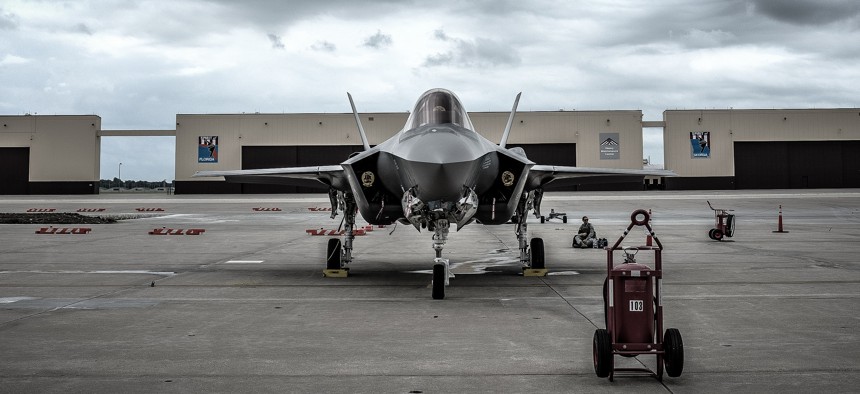
Image via Flickr user Heath Cajandig
Lasers Could Be Coming To The F-35
Advances across a range of fields could enable a sci-fi upgrade to the fighter jet.
Lockheed Martin’s new modular fiber lasers now convert fully 40 percent of input energy to output, which means that — along with advances in manufacturing, targeting, and size-weight-power minimization — the company’s now talking about putting a laser weapon on the F-35 Joint Strike Fighter.
“We are absolutely looking at concepts for integration,” Robert Afzal, the company’s senior fellow of laser systems and sensors, told reporters yesterday.
Unlike solid-state bulk lasers that rely on crystal components, or powerful but unstable chemical lasers, fiber lasers generate their beams inside fiber optics, making the device more flexible and efficient. Afzal compared it to a prism that works in reverse. Whereas a prism takes light and fractures it into beams of different colors, a fiber laser merges several beams into one.
Moreover, Lockheed Martin has developed a way to adjust a laser weapon’s output by adding modules, allowing it to be tailored for missions or threats.
The company is under contract to deliver a 60-kilowatt fiber laser to the Pentagon next year. “The Army has the option to add more modules and increase power from 60kW to 120kW as a result of the laser's modularity,” the company said in a press release.
“Because the laser is so electrically efficient, the laser weapon will be smaller than previous technologies,” said Afzal.
Those efficiency gains could make it suitable for jets. The company faces competition from rival General Atomics, which has already delivered a 150-kilowatt solid-state laser to the Pentagon for testing and is looking into mounting one on the company’s Predator C drone.
The Air Force has recently become more bold in its predictions that a laser could be airborne by 2020. For instance, the Missile Defense Agency recently announced that they were revamping the Airborne Laser Program that was shuttered in 2012. The goal is to fly an airborne laser demonstrator in 2021.
“Everybody thinks you have a tendency to talk about high-powered microwaves and lasers and it’s kind of science fiction,” Air Combat Command leader Gen. Herbert Carlisle, the leader of Air Combat Command, said at the recent Air Force Association Air and Space Conference. “But this is a reality. … I believe that we will have a directed energy capability in a pod that can be mounted on a fighter aircraft very soon.”
Afzal cautioned that an F-35 laser was currently mostly a topic of interest and discussion within the company.
“What we’re doing is we’re looking at the concepts. How would a system even go into the F-35? And we’re also looking into the utility and doing models and calculations to see the utility,” he said.
And Air Force officials have hinted that they’re interested in putting a laser on the jet, although other have noted that such a weapon would primarily be intended to protect a plane from enemy aircraft — something the F-35’s stealth features are already supposed to do.
“We’re certainly talking to the Air Force about their plans, their roadmap, for developing laser weapons for F-35 and other platforms. We would want to do that in partnership with the Air Force,” said Iain Mckinnie, business development lead for Laser Sensors and Systems, Lockheed Martin Mission Systems and Training.




